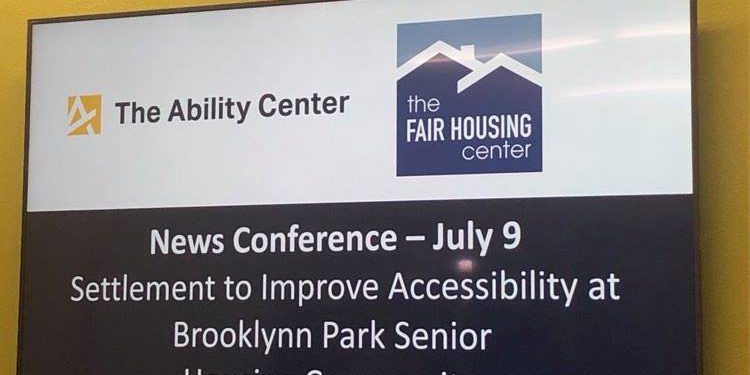A settlement has been reached in a lawsuit filed by The Fair Housing Center, The Ability Center, and Brooklynn Park resident Jenny Tillman that requires defendants to complete extensive accessibility modifications for Brooklynn Park and pay $400,000 in damages to cover fees, litigation costs, and compensation for the nonprofit organizations’ diversion of resources and frustration of mission. Remediation for the 55+ housing community, conducted at the defendants’ expense, will help bring properties into compliance with design and construction requirements and ensure residents of the senior housing development can benefit from full use and enjoyment of their owner-occupied villas while they continue to age in place. Plaintiffs were represented by Stephen Dane of Dane Law LLC and Relman Colfax PLLC.
Plaintiffs filed a joint lawsuit in 2018 in the U.S. District Court for the Northern District of Ohio, accusing Moline Builders, Inc., JLJ Development, LLC, James E. Moline, Lance Fuller, Larry Fast, Oravecz & Associates, Inc., Graham Design Group, LLC, and Joel Graham of discriminating against persons with disabilities by failing to comply with federal design and construction regulations for accessible housing.
“Having lived with MS for 30 years, I bought my home thinking about my future. After moving in and living in my home, it became clear it was not accessible to me or others in this community,” stated Jenny Tillman, Brooklynn Park resident. “The step at my front door can be difficult for me, so often I can’t even use my main entrance and have to enter the house through the garage. I asked the builders many times to make changes to make it accessible but they refused. I’m looking forward to no longer facing daily challenges just trying to get around my home, and I’m grateful to The Fair Housing Center and The Ability Center for standing by me.”
“Fair housing ensures everyone can choose where they live and people with disabilities can find homes that meet their needs,” explained Marie Flannery, President and CEO of The Fair Housing Center. “Because of the limited supply of accessible housing, people with mobility impairments and seniors have limited choice in where they can live. If builders do not comply with the Fair Housing Act, they continue to limit those choices. Hopefully, this case helps to increase awareness in the design and construction industry about the ways the Fair Housing Act applies to them. Improving compliance not only benefits those seeking accessible housing, but can also help builders and developers avoid costly violations.”
“An accessible home is the foundation of independence for people with disabilities,” said Tim Harrington, Executive Director of The Ability Center. “As The Ability Center continues the quest to become the disability-friendly community in the country, we value partners that protect the rights of people with disabilities to live in the community of their choosing. We hope this outcome begins to fuel conversations around universal design housing builds that will create greater stock of accessible homes in our area.”
“Ensuring that Brooklynn Park Villas complies with the Fair Housing Act adds 92 accessible units to our Toledo area housing stock and ensures that residents can maintain independence, stay connected to the community, and remain in their homes as they age,” stated Katie Hunt Thomas, Disability Rights Attorney and Director of Advocacy with The Ability Center. “We believe that educating the community about issues that affect people with disabilities is key to improving accessibility and paving the way toward a community where everyone can feel at home.”
The Fair Housing Center and The Ability Center both emphasize their role as resources for the housing industry, encouraging builders and developers to proactively contact them for assistance with reviewing plans, understanding their responsibilities, and ensuring compliance with applicable laws and regulations.
Highlights of the Settlement:
• Defendants will pay $400,000 in damages to cover fees, litigation costs, and compensation for the nonprofit organizations’ diversion of resources and frustration of mission.
• Over the next four years, the developers of the project will also work to make remediations to the project to ensure that it is more accessible for persons with disabilities.
• These remediations will be provided for free, at no cost at all, for the residents and the homeowners association.
• The residents will receive notices from the developers about the availability of the free remediations.
• Over the course of the four-year period, if a new resident purchases a home, they will also have the option to obtain the free remediations.
• Remediations will consist of modifications to common areas and individual residences including: creating accessible entrances where steps or slopes currently impede access; modifying routes to enable access between different areas of the housing development; moving mailboxes, light switches, thermostats, and other fixtures to compliant heights; installing accessible door handles and parking spaces; correcting sidewalk slopes, curb cuts, and ramps; and removing obstacles that block access to key amenities.
This case also established an important legal precedent that will have a far-reaching impact on other similar cases. In a ruling on Summary Judgment, the Court found that the accessibility requirements for front entrances remain even if the housing developer asserts that other entrances, like the garage door, may be accessible. This particular issue in the case was one of first impression, meaning that no other court had specifically decided this legal issue. The Court found “Whether one is a… neighbor [who uses a wheelchair], friend, or family member, a political candidate, or a repairman – all are making ‘public use’ as they approach a [housing] unit’s sidewalk-adjoining front door. Not to let them get there unimpeded, and, in effect, to send them away as if unwelcome, is precisely the discrimination the FHAA forbids.” This decision will undoubtedly help guide the law on accessibility requirements and assist other persons with disabilities in the future.
Case Background
Brooklynn Park Villas is a senior community built between 2014-2018 that was advertised as “fully accessible.” Seniors and people with disabilities, attracted to the community because it was advertised as fully accessible, purchased units that have inaccessible kitchens, bathrooms, and for many, inaccessible entrances on a campus with inaccessible community center and sidewalks that are too steep. Many seniors purchased condos in order to age in place but ended up with unlivable homes.
In 2016, The Fair Housing Center contacted the defendants to let them know that the villas were out of compliance with accessibility standards and asked them to assist residents by fixing the issues. However, the defendants refused to bring residents’ villas up to accessibility design standards. When The Fair Housing Center and The Ability Center returned to the property a year later, they discovered that new villas constructed after the defendants had been notified of the violations exhibited the same accessibility obstacles. At that point, the organizations determined that a lawsuit was the only way to ensure that residents were able to live in accessible homes. Examples of accessibility violations include: many entrances contain steps; walkways are impassable due to steep slopes or lack of curb cuts; environmental controls, mailboxes, and other amenities are located out of reach; and kitchens and bathrooms do not provide sufficient clear floor space to be usable by persons with disabilities.
Need for Accessible Housing
While many people with disabilities are able to live independently, current research shows that a growing number are unable to find accessible housing that meets their needs. Likewise, many seniors wish to age in place but are not able to find an apartment due to physical barriers. People with disabilities and the aging who are unable to find housing that is accessible are often forced to move out of their own homes into institutional housing such as nursing homes. Because of this, Congress amended the Fair Housing Act in 1988 to require all new, multi-family housing built after March 13, 1991 with four or more units to meet certain accessible design guidelines.
Stats from Ohio Housing Finance Agency – Ohio Needs Assessment. July 1, 2018 – June 30, 2019
• Fourteen percent of Ohioans, roughly one in seven, reported having one or more disabilities.
• Most reported an ambulatory difficulty, meaning that walking and/or climbing stairs is a substantial challenge.
• A quarter of adults aged 65 to 74 and nearly half of adults aged 75 and over have a disability.
• 62.9% of housing in Ohio does not even have an accessible entrance and only 36.7% of entrances to housing are accessible.


